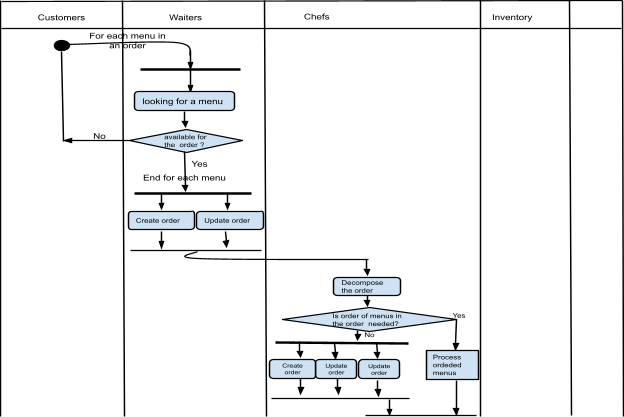Discussion and Interview Agenda
Setting
Objective of interview
Determine process of making orders and how orders are scheduled.
Data, Time, and Location
October 15, 2013 at 12:00 PM in the restaurant.
User participants
John Whilser, vice president of the restaurant, Raymond Fong, Service department manager, and Tim Tabasuki, Manager of production
Project Team Participants
Yan
Interview/ Discussion
1. Who is eligible to make orders?
Waiters and manager.
2. Who is eligible to modify orders?
Waiters and manager.
3. What information must be in an order?
Table number, name of person who made the order, type of order delivery(take out or not?), number of customers of each order, menu names, size of each menu(small, medium, and large), and number of orders of each menu.
4. How do customers respond to waiting time of orders?
customers who have already served some food is more tolerant of delay than those who have nothing on the table. Some customers is likely to cancel those unserved food or just leave if delay is over 20 minutes.
5. What are the expectations for the order sub-system?
A. Order can be made through mobile devices.
B. Order information can be shared to casher in case customers want to verify what they have eaten when making payment.
C. Order information should contain all the details of any update(add or remove menus after the order is made).
D. the system can inform the waiters when an order is not available due to some reasons (not enough inventory etc.)
E. the system will automatically disable those unavailable menus so that waiters would know the information in advance.
6. Who make the decision to pick which order to product of a list of orders?
Only the chief chef.
7. How to decide the schedule of a set of orders to be produced?
First in first serve strategy. In addition, They group menus from a sequence of orders base on the first one.
8. What constraints affect the decision of scheduling?
A. order of the incoming food orders.
B. capacity of the oven
C. whether sequence of menu of an order is important or not.
9. What to do if there was unexpected events such as no inventories or defective products.
if there were no inventories, the menu should be disable in the system.
if there were defective products, stop process of all food of the same type of defective products until problem is solved.
10. What are the expectations for the auto scheduling algorithm?
the system can handle the constraint of 8.c above.
orders can be decomposed into suborder for different ovens in the kitchen so that chef would get the right orders.
Follow-Up
Date and time of next meeting or follow-up session
October 20, 2013, at 12:00 PM
Activity Diagram

No comments:
Post a Comment